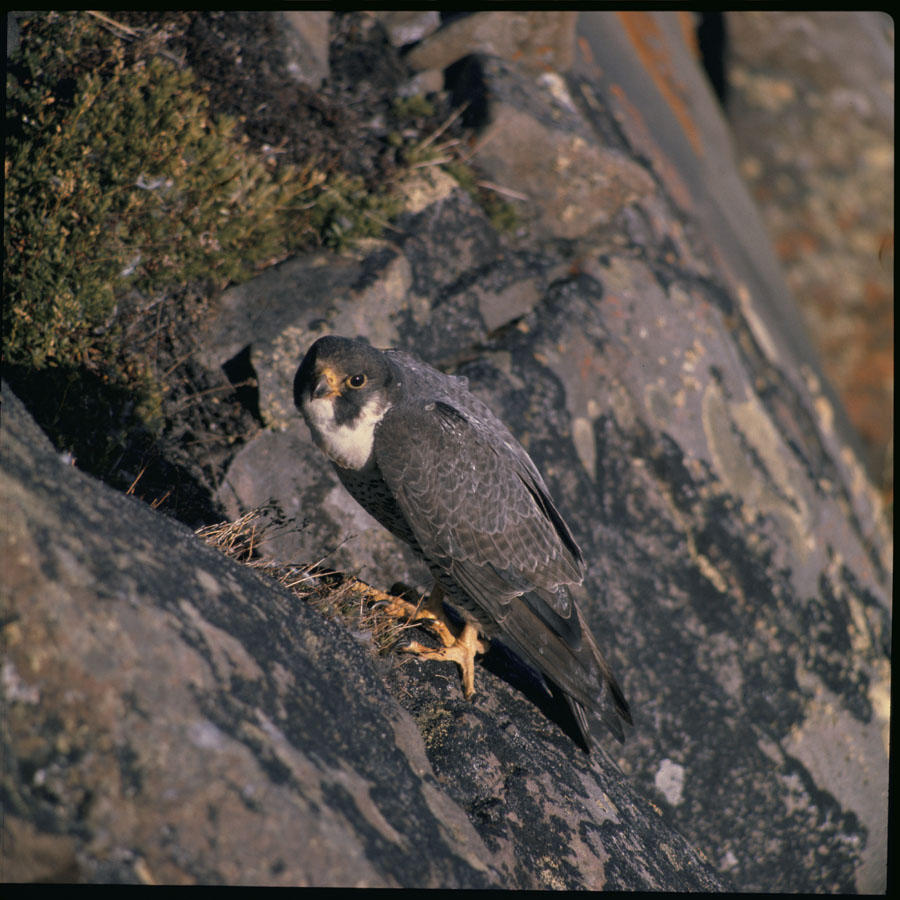Title: Arctic Peregrine Falcon, Alternative Title: falco peregrinus tundrius, Creator: Maslowski, Steve, Source: WO-5230-51, Publisher: U.S. Fish and Wildlife Service, Contributor: DIVISION OF PUBLIC AFFAIRS. Language: EN - ENGLISH, Rights: (public domain), Audience: (general), Subject: raptor, birds, animal.
Peregrine Falcon Its name comes from the Latin word peregrinus, meaning foreigner or traveler.
Three subspecies of the peregrine falcon inhabit North America: the American (Falco peregrinus anatum), Arctic (Falco peregrinus tundrius), and Peale’s (Falco peregrinus pealei). Peregrine falcons are roughly crowsized, about 15 to 21 inches long with a wingspan of about 40 inches. As with many raptors, or birds of prey, females are larger than males. Adults have slate blue-gray wings and backs barred with black; pale undersides; white faces with a black stripe on each cheek; and large, dark eyes. Younger birds are darker below and browner.
Peregrine falcons live mostly along mountain ranges, river valleys, and coastlines. Historically, they were most common in parts of the Appalachian Mountains and nearby valleys from New England south to Georgia, the upper Mississippi River Valley, and the Rocky Mountains.
Peregrines also inhabited mountain ranges and islands along the Pacific Coast from Mexico north to Alaska and in the Arctic tundra. The peregrine falcon also is found in other parts of the world. Most peregrines from northern Alaska, Canada, and Greenland migrate in the fall to Central and South America.
Peregrine falcons generally reach breeding maturity at 2 years of age. Usually, the male arrives at a nesting site and begins a series of aerial acrobatic displays to attract a mate. An average clutch of four eggs is laid in the spring, hatching about a month later. Peregrines vigorously defend their nests, although they may abandon them if severely or continuously harassed.
The nest is a scrape or depression dug in gravel on a cliff ledge. Rarely, peregrines will nest in a tree cavity or an old stick nest. Some peregrines have readily accepted manmade structures as breeding sites. For example, skyscraper ledges, tall towers, and bridges serve as the urban equivalent of a cliff ledge.
In 1988, 21 nesting pairs of peregrines in various urban areas throughout North America successfully fledged more than 40 young. Peregrine falcons feed primarily on other birds, such as songbirds, shorebirds, ducks, and in urban areas starlings and pigeons. Flying high above their intended prey, peregrines will stoop or dive and strike in mid-air, killing the prey with a sharp blow. Scientists estimate the speed of a diving peregrine to be more than 200 miles per hour.
This file is a work of a U.S. Fish and Wildlife Service employee, taken or made during the course of the person's official duties. As a work of the U.S. federal government, the file is in the public domain.
Generally speaking, works created by U.S. Government employees are not eligible for copyright protection in the United States. See Circular 1 "COPYRIGHT BASICS" PDF from the U.S. Copyright Office.
Unless otherwise indicated, resources in the Digital Library System are in the public domain. No restrictions or copyrights are placed upon these materials. You may credit the source of the resource using the information contained in the "Creator" or "Rights" field of the resource record.
Text Credit: U. S. Fish and Wildlife Service
Let this small sampling be a guide to better quality, more plentiful, public domain, royalty free, copyright free, high resolution, images, stock photos, jpeg, jpg, free for commercial use, clip art, clipart, clip-art.











No comments:
Post a Comment